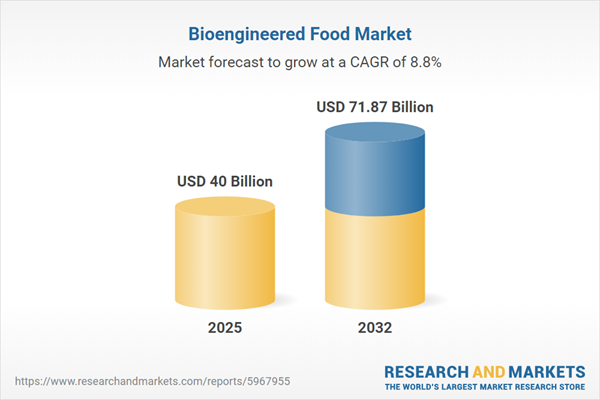Speak directly to the analyst to clarify any post sales queries you may have.
The bioengineered food market is evolving quickly as organizations adjust to fresh regulatory landscapes, increased investment in food science, and rising sustainability expectations. Senior executives are adapting strategies and operations to seize new growth opportunities and address industry shifts.
Market Snapshot: Bioengineered Food Market Size and Growth
In 2024, the global bioengineered food market achieved USD 36.71 billion, with expectations of reaching USD 40.00 billion by 2025 and a projected CAGR of 8.75% through 2032. Steady capital commitment, broader adoption of advanced food science, and favorable regulatory trends are promoting strong growth across the sector. C-suite leaders are enhancing sustainability strategies and updating compliance processes, solidifying bioengineered food's position at the forefront of food technology transformation. Market enthusiasm is driving further innovation, making this sector integral to reshaping food systems at a global scale.
Scope & Segmentation of the Bioengineered Food Market
This report gives a comprehensive segmentation framework to support informed decision-making for senior leadership. The bioengineered food market is shaped by the following key factors:
- Product Type: Focus includes cell culture components such as growth media and scaffolds enabling cultivated food production, advanced agricultural inputs for crop yield improvement, engineered livestock feed optimizing animal nutrition, and microbial products including enzymes and biofertilizers enhancing process sustainability.
- Technology: Gene-editing tools and targeted RNA interference technology facilitate precision in food innovation. Synthetic biology increases scalability, while process automation enhances efficiency. The integration of these technologies accelerates the development of advanced food and nutraceutical solutions relevant to multiple industries.
- Application: Market applications span crop protection, protein synthesis, plant-based food innovation, and the improvement of enzymatic processing. Innovations in nutraceutical manufacturing enable firms to align offerings with evolving consumer health trends, supporting product adaptation.
- End User: Stakeholders range from feed suppliers and food and beverage manufacturers to pharmaceutical companies utilizing bioengineered materials, as well as research organizations at the forefront of food science developments.
- Geographic Regions: The Americas, Europe, Middle East and Africa, and Asia-Pacific offer distinct commercial and regulatory approaches. Regional differences affect product adoption and the integration of sustainability targets into local strategies.
- Leading Companies: Market participants include Bayer AG, Corteva Agriscience, Syngenta AG, BASF SE, Limagrain Holding, KWS SAAT, Sakata Seed Corporation, Vilmorin & Cie, Rijk Zwaan Zaadteelt en Zaadhandel, and Land O’Lakes, recognized for innovation and strategic growth.
Key Takeaways for Senior Decision-Makers
- Biotechnology and synthetic approaches offer new channels to diversify product lines and adapt rapidly to evolving regulatory requirements.
- Efforts to standardize cross-border regulations are streamlining international market operations and enabling broader global expansion opportunities.
- Digital supply chain solutions increase transparency, simplify compliance, and contribute to meeting global sustainability benchmarks.
- Public and private sector partnerships are accelerating innovation timelines and fostering constructive engagement with policymakers in priority markets.
- Regional leadership varies; while North America and Asia-Pacific are quick adopters of technology, Europe focuses on robust compliance and rigorous risk assessment in both policy and practice.
- Agility in supply chain management and continuous product innovation position companies to remain resilient as market and regulatory conditions shift.
Tariff Impact on Global Bioengineered Food Supply Chains
Planned tariff adjustments in the United States for 2025 are prompting global producers to revisit supply chain and cost management strategies. Many organizations are adjusting supplier networks, establishing new partnerships, and renegotiating procurement terms to protect margins. Ongoing engagement with regulators plays an important role in maintaining supply chain stability and supporting adaptation during periods of transition.
Methodology & Data Sources
The insights in this report are built upon direct interviews with industry stakeholders, expert opinions from recognized authorities, and analysis of peer-reviewed scientific literature. Data validation spans academic, regulatory, and commercial resources, ensuring a robust foundation for strategic decisions at the executive level.
Why This Report Matters to Decision-Makers
- Pinpoint optimal avenues for market expansion by targeting bioengineered food applications with the highest potential for return and strategic fit.
- Advance strategic planning through actionable regulatory insights, supporting compliance, risk control, and efficient cost management.
- Utilize trusted benchmarking and compliance resources to foster innovation and sustain a competitive advantage as food technologies evolve.
Conclusion
This report enables senior leaders to anticipate industry and regulatory changes, formulate adaptable strategies, and address emerging challenges to support organizational resilience and sustainable progress in the bioengineered food market.
Additional Product Information:
- Purchase of this report includes 1 year online access with quarterly updates.
- This report can be updated on request. Please contact our Customer Experience team using the Ask a Question widget on our website.
Table of Contents
3. Executive Summary
4. Market Overview
7. Cumulative Impact of Artificial Intelligence 2025
Companies Mentioned
The companies profiled in this Bioengineered Food market report include:- Bayer AG
- Corteva Agriscience, Inc.
- Syngenta AG
- BASF SE
- Limagrain Holding S.A.
- KWS SAAT SE & Co. KGaA
- Sakata Seed Corporation
- Vilmorin & Cie
- Rijk Zwaan Zaadteelt en Zaadhandel B.V.
- Land O'Lakes, Inc.
Table Information
| Report Attribute | Details |
|---|---|
| No. of Pages | 196 |
| Published | November 2025 |
| Forecast Period | 2025 - 2032 |
| Estimated Market Value ( USD | $ 40 Billion |
| Forecasted Market Value ( USD | $ 71.87 Billion |
| Compound Annual Growth Rate | 8.7% |
| Regions Covered | Global |
| No. of Companies Mentioned | 11 |









